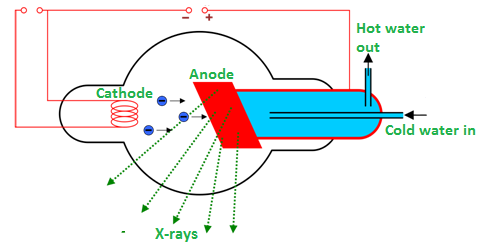Production of X-rays
It is an electromagnetic wave of high energy and very short wavelength, which is able to pass through many materials opaque to light.Production of x-raysX-rays are produced when the ...

X-Ray Diffraction
The diffraction effects can be observed only if the spacing between the lines ruled on the grating is of the order of magnitude of the wavelength of light used. The grating element for the usual gratings is of the order of 10 -6 m in the diffraction of a beam of light. A transmission diffraction grating has about 6000 lines per cm in a piece of glass. The width of the slit between two lines is of the order of wavelength of light and hence is used to study diffraction of ordinary light. The wavelength of X-ray is the order of 1/1000th of that of the grating used in the visible region of the wavelength of the visible light. Therefore, to observe diffraction with X-rays, we need a grating having a spacing 1/1000th the visible region.


(a)X-ray diffraction through a crystal (b) Laue spots
In 1913 Laue experimentally showed the diffraction of X-rays through a crystal. The experimental arrangement is shown in the figure. T is a source of X-rays which gives X-ray beam of continuous range of certain wavelengths. A narrow beam of X-rays from the X-ray tube is collimated by two slits S1 and S2 and is passed through a zinc sulfide crystal and allowed the emerging beam to fall on a photographic plate as shown in the figure (b). After an exposure of several hours and on developing the plate, many faint but regularly arranged spots around a central bright spot were observed on the plate as shown in fig.(b). These spots are known as Laue spots and is due to the diffraction on X-rays. From this experiment it was concluded that
1. X-rays are electromagnetic waves and
2. The atoms of a crystal are arranged in a regular three dimensional lattice.